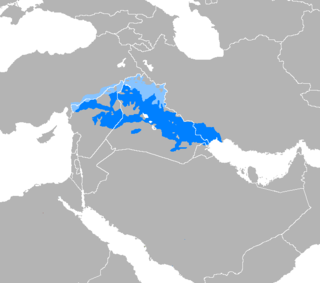Mesopotamian Arabic (Arabic: لهجة بلاد ما بين النهرين) or Iraqi Arabic (Arabic: اللهجة العراقية) is a group of varieties of Arabic spoken in the Mesopotamian basin of Iraq, as well as in Syria, Kuwait, southeastern Turkey, Iran, and Iraqi diaspora communities.[2]
| Mesopotamian Arabic | |
|---|---|
| Iraqi Arabic | |
| اللهجة العراقية | |
| Native to | Iraq (Mesopotamia), Syria, Turkey, Iran, Kuwait, parts of northern and eastern Arabia |
| Region | Mesopotamia, Cilicia |
| Ethnicity | Mainly Iraqi Arabs also used as an L1 or L2 by non Arab communities in the region |
| Speakers | Gelet/South (acm): 17 million (2020)[1] Qeltu/North (ayp): 10 million (2020)[1] |
Afro-Asiatic
| |
| Dialects | |
| Arabic alphabet | |
| Iraqi Sign | |
| Language codes | |
| ISO 639-3 | Either:acm – Geletayp – Qeltu |
| Glottolog | meso1252nort3142 |
 Areas where Mesopotamian Arabic are widely spoken.[image reference needed] | |
History
Aramaic was the lingua franca in Mesopotamia from the early 1st millennium BCE until the late 1st millennium CE, and as may be expected, Mesopotamian Arabic shows signs of an Aramaic substrate.[3] The Gelet and the Judeo-Iraqi varieties have retained features of Babylonian Aramaic.[3]
Varieties
Mesopotamian Arabic has two major varieties: Gelet Mesopotamian Arabic and Qeltu Mesopotamian Arabic. Their names derive from the form of the word for "I said" in each variety.[4] Gelet Arabic is a Bedouin variety spoken by Muslims (both sedentary and non-sedentary) in central and southern Iraq and by nomads in the rest of Iraq. Qeltu Arabic is an urban dialect spoken by Non-Muslims of central and southern Iraq (including Baghdad) and by the sedentary population (both Muslims and Non-Muslims) of the rest of the country.[5] Non-Muslims include Christians, Yazidis, and Jews, until most Iraqi Jews left Iraq in the 1940s–1950s.[6][7] Geographically, the gelet–qeltu classification roughly corresponds to respectively Upper Mesopotamia and Lower Mesopotamia.[8] The isogloss is between the rivers Tigris and Euphrates, around Fallujah and Samarra.[8]
During the Siege of Baghdad (1258), the Mongols killed all Muslims.[9] However, sedentary Christians and Jews were spared and northern Iraq was untouched.[9] In southern Iraq, sedentary Muslims were gradually replaced by Bedouins from the countryside.[9] This explains the current dialect distribution: in the south, everyone speaks Bedouin varieties close to Gulf Arabic (continuation of the Bedouin dialects of the Arabian Peninsula),[9][10] with the exception of urban Non-Muslims who continue to speak pre-1258 qeltu dialects while in the north the original qeltu dialect is still spoken by all, Muslims and Non-Muslims alike.[9]
| s-stem | Bedouin/gelet | Sedentary/qeltu |
|---|---|---|
| 1st sg. | ḏạrab-t | fataḥ-tu |
| 2nd m. sg. | ḏạrab-t | fataḥ-t |
| 2nd f. sg. | tišṛab-īn | tǝšrab-īn |
| 2nd pl. | tišṛab-ūn | tǝšrab-ūn |
| 3rd pl. | yišṛab-ūn | yǝšrab-ūn |
Dialects
Gelet dialects include:[8]
- Gilit
- Northwestern Mesopotamian group
- Shāwi dialects (including Urfa and al-Raqqah)
- Rural dialects of northern and central Iraq.
- Central Iraqi Group
- Baghdad Arabic
- The surrounding area around Baghdad
- Southern Iraqi and Khuzestani Arabic group
- Urban dialects
- Rural dialects
- Marshland dialects of the Marsh Arabs of the Mesopotamian Marshes
- Northwestern Mesopotamian group
Qeltu dialects include:[8]
- Qeltu
- Anatolian Qeltu
- Tigris Qeltu
- Euphrates Qeltu
- Khawetna (Syria, Iraq, Turkey)
- Deir ez-Zor
- Anah and Abu Kamal
- Hit, Iraq
Baghdadi Arabic is Iraq's de facto national vernacular, as about half of population speaks it as a mother tongue, and most other Iraqis understand it. It is spreading to northern cities as well.[12] Other Arabic speakers cannot easily understand Moslawi and Baghdadi.[12]
Substrate
Mesopotamian Arabic, especially Qeltu, has a significant Eastern Aramaic substrate,[13] and through it also has significant influences from ancient Mesopotamian languages of Sumerian and Akkadian. Eastern Aramaic dialects flourished and became the lingua franca throughout Mesopotamia during the Achaemenid and Hellenistic period, where different dialects such as Syriac, Mandaic and Hatran Aramaic came to being.[14][15] Mesopotamian Arabic also retains influences from Persian, Turkish, and Greek.[16]
See also
References
Further reading
- Palva, Heikki (2009-01-01). From Qəltu To Gələt: Diachronic Notes On Linguistic Adaptation In Muslim Baghdad Arabic. Brill. ISBN 978-90-474-2559-5.
